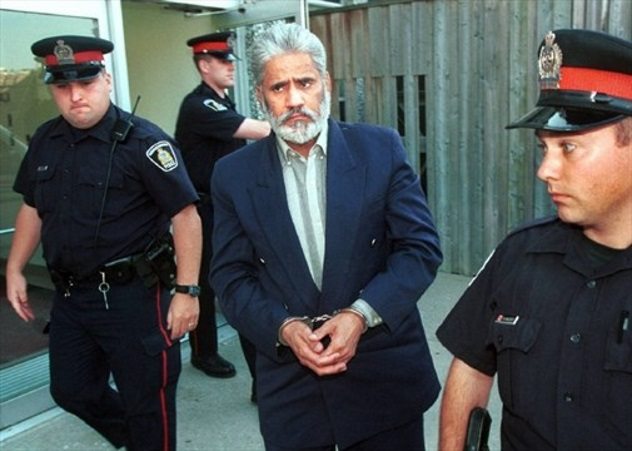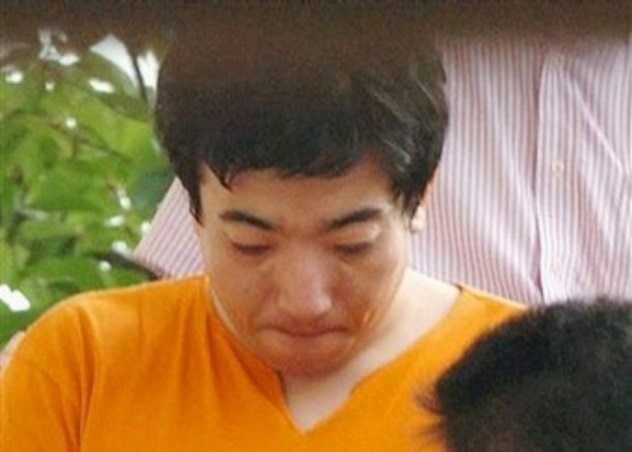 Humans
Humans  Humans
Humans  Animals
Animals 10 Animals That Humiliated and Harmed Historical Leaders
 History
History 10 Most Influential Protests in Modern History
 Creepy
Creepy 10 More Representations of Death from Myth, Legend, and Folktale
 Technology
Technology 10 Scientific Breakthroughs of 2025 That’ll Change Everything
 Our World
Our World 10 Ways Icelandic Culture Makes Other Countries Look Boring
 Misconceptions
Misconceptions 10 Common Misconceptions About the Victorian Era
 Mysteries
Mysteries 10 Strange Unexplained Mysteries of 2025
 Miscellaneous
Miscellaneous 10 of History’s Most Bell-Ringing Finishing Moves
 History
History 10 Great Escapes That Ended Right Back in Captivity
 Humans
Humans 10 Everyday Human Behaviors That Are Actually Survival Instincts
 Animals
Animals 10 Animals That Humiliated and Harmed Historical Leaders
 History
History 10 Most Influential Protests in Modern History
Who's Behind Listverse?

Jamie Frater
Head Editor
Jamie founded Listverse due to an insatiable desire to share fascinating, obscure, and bizarre facts. He has been a guest speaker on numerous national radio and television stations and is a five time published author.
More About Us Creepy
Creepy 10 More Representations of Death from Myth, Legend, and Folktale
 Technology
Technology 10 Scientific Breakthroughs of 2025 That’ll Change Everything
 Our World
Our World 10 Ways Icelandic Culture Makes Other Countries Look Boring
 Misconceptions
Misconceptions 10 Common Misconceptions About the Victorian Era
 Mysteries
Mysteries 10 Strange Unexplained Mysteries of 2025
 Miscellaneous
Miscellaneous 10 of History’s Most Bell-Ringing Finishing Moves
 History
History 10 Great Escapes That Ended Right Back in Captivity
10 Grisly Murders With Intriguingly Peculiar Backstories
All murders are tragic, untimely, and not to be trivialized. Sometimes, though, out of a combination of morbid fascination and the rich tapestry that makes up the human existence, the backstories to them enthrall the public—even for decades after.
Whether it’s to assume a person’s identity, to collect huge amounts of insurance money, or even to make good on a prearranged agreement with the victim to commit their own murder, the world of homicide is dark, depressing, and despair-inducing. It’s also a world where, at times, truly unique events unfold in ways that both shock and captivate most of us.
10 Sharon Lopatka Arranged Her Own Sex Murder Online

When police discovered the body of 35-year-old Sharon Lopatka in a shallow grave in North Carolina in October 1996, it would not only result in one of the strangest of cases but one widely regarded as the first to use e-mail exchanges as a huge part of the evidence in court.[1]
At a time when the Internet was just beginning to take its grip on the social consciousness, Lopatka was eagerly exploring chat rooms—particularly ones that explored users’ sexual fetishes and fantasies. Lopatka’s fantasies were a little wilder than most. She was looking for someone who would “torture her sexually and then snuff out her life.”
She had approached one man directly online, but after he realized her proposal was serious, he declined. When Sharon propositioned a user by the online name of “Slowhand,” however, he agreed to her request.
Slowhand would be revealed to be Robert Glass, a state government computer operator and divorced 45-year-old. Lopatka made excuses to her family of visiting friends in Virginia, before leaving her native Baltimore and making her way to North Carolina, fully aware (as her e-mails would show) that she was willingly traveling to her death.
Sharon left a note for her husband stating that she would be happy and that he was “not to go after the one who did this to her.” When he filed a missing persons report, the police noticed the computer in the family home and requested if they could examine it. It was then that they discovered the e-mails essentially laying out the pair’s twisted plot.
An autopsy showed Lopatka was strangled to death, and Glass would be found guilty of voluntary manslaughter. Incidentally, he was due to be released from jail in the early 2000s but died of a heart attack in February 2002 while still incarcerated.
9 Murder In Paradise

When Berlin physician Friedrich Ritter came to the island of Floreana in the Galapagos Islands in 1929 with his lover Dore Strauch, it was neither developed nor inhabited. A small island around 80 kilometers (50 mi) from Santa Cruz, the nearest neighboring island with even any suggestion of a populace, Floreana would be their paradise.
Shortly afterward, the Wittners, Heinz, Magrett, and their teenage son, also moved to the island. However, the expected paradise of Ritter and Strauch as well as the Wittners was about to take a turn for the worst with the arrival of “Baroness” Eloise Wehrborn de Wagner-Bosquet in 1931. She was accompanied by Robert Phillipson (one of her lovers), Rudolph Lorenz (another alleged lover), and an Ecuadorian named Manuel Valdivieso.
Wagner-Bosquet had managed to secure a patch of land through a contact in the Ecuador government. The land, however, contained a water spring that the Wittmers had been using. When the island was hit by a drought, things began to turn nasty.
Ritter wasn’t happy about more people encroaching on their ideal island in the Sun, and the Wittmers blamed Wagner-Bosquet and her entourage for the drought and the limiting of their use of the spring. Wagner-Bosquet herself was said to “play her lovers off against each other.” In short, she hadn’t exactly made friends fast on the island.
On March 17, 1934, Wagner-Bosquet allegedly arrived at the Wittmers’ house and stated that she and Phillipson were leaving the island on a yacht that was destined for Tahiti. It belonged to friends who had arrived that day—at least that was the story Margaret Wittmer told. Neither Wagner-Bosquet nor Phillipson were ever seen again.[2]
No one else, it seemed, could recall a yacht or any other boat arriving on the island that day. Wagner-Bosquet had also left practically all of her things behind, supposedly in the care of Lorenz. Again, that was the story that Margret told.
Following her disappearance, other suspicious activity unfolded on the once-magical island. Ritter himself died, allegedly from food poisoning from eating infected chicken. This is particularly strange, as Ritter was a vegetarian.
Lorenz had also began to act nervous and desperate to get off the island. He paid a Norwegian fisherman to help him get to Santa Cruz. However, they, too, did not make their destination. Instead, their bodies were both discovered on the island of Marchena, almost mummified.
Strauch returned to Germany and insisted in a book she wrote that Lorenz had killed Wagner-Bosquet and Phillipson, possibly out of jealousy. However, it appears that Margaret Wittmer may have been involved, directly or indirectly, in the lovers’ deaths and quite possibly in those of Ritter and Lorenz as well.
8 Armin Meiwes Requested Someone He Could Murder (And Eat)

On December 10, 2002, Armin Meiwes was arrested and charged with the murder of 43-year-old Bernd Brandes.[3] The police had him bang to rights. They even had the body of the victim—albeit cut into fillets and chops, with portions already devoured by Meiwes.
The case would shock Germany and would be followed worldwide as one of the truly bizarre and disturbing acts of the young 21st century. The episode was filmed by Meiwes and is said to run to four hours of footage. It is claimed to be so disturbing that only 19 minutes were allowed in the courtroom—a closed court at that.
Meiwes, according to reports and investigations that followed, and fantasized about eating a person since being eight years old. He had even placed an advert on the Internet in March 2001 stating he desired a “young, well-built man who wanted to be eaten.” However, it was an advert placed by the eventual victim that Meiwes responded to when he noticed the title “Dinner—or your dinner” and the fact that the ad offered “the chance to eat me alive.”
The two men would meet at the train station in Rotenburg and then retreat to Meiwes’s isolated farmhouse. After the two had sex, at least according to Meiwes, Brandes swallowed 20 sleeping tablets with alcohol and asked Meiwes to cut off and fry his penis so that they could both eat it. Meiwes did, and they ate, before Meiwes calmly went to run the now-drowsy Brandes a bath before helping him into it.
He would return periodically to check on Brandes’s state, while reading a Star Trek novel. Then, shortly before dawn, Meiwes stabbed the dying man in the neck, before butchering and filleting his body, storing the cuts of meat neatly in his chest freezer.
He would leave one piece out, though: a rump steak that was actually a piece of Brandes’s back. He cooked it and ate it with princess potatoes and sprouts. Years later, from his prison cell, he would describe the taste as being “like pork, but stronger.”
Meiwes was originally convicted of manslaughter in 2004 but was later retried and convicted of murder. He is currently serving life in prison.
7 Jeffrey Locker Arranges His Own Murder For Insurance

Jeffrey Locker was a motivational speaker, and a very good and sought-after one. He was also a great family man—so much so that he arranged his own murder, allowing them to cash in on a multimillion-dollar life insurance policy. That this was the case is not in doubt. Both the prosecution against the hired hit man, Kenneth Minor, and his defense attest to this. What they argued over was whether Minor was a cold-blooded killer or whether Locker was a manipulative individual who used Minor to his own, admittedly tragic, end.
The killing occurred on July 16, 2010. By this time, Locker was deeply in debt. He had attempted to make a deal with a known career criminal from Harlem during a trip from his Long Island home. When that didn’t work out, a chance meeting with Minor resulted in Locker making the blunt offer of killing him in exchange for money.
Minor would argue that he assisted Locker in committing suicide but didn’t kill him. He stated that Locker’s concern was that it “had to look like a murder” so his family could collect the insurance payout. Locker would be found dead in his car, bound and stabbed.
Minor was convicted of the murder and sentenced to 20 years in prison. In October 2014, he would have his sentence reduced to 12 years.[4]
Incidentally, a judge would rule that the insurance payout to the Locker family should be made null and void due to inaccurate claims of Locker’s income in his application. He had stated he earned $800,000 yearly when, in fact, he earned a little over $200,000.
6 The Poisoner Who Murdered In Two Countries

The killing spree of Sukhwinder Dhillon stretched from Hamilton, Canada, to Punjab, India, as he not only murdered his business partner, Ranjit Singh Khela, but also his wife, Parvesh Kaur Dhillon. Both were poisoned, with the motive for each being for Sukhwinder to claim their life insurance money.[5]
In between these two murders, while in Punjab, Dhillon married three wives in order to collect the dowry payments for doing so. He killed the second wife and also murdered his two twin baby boys from his first wife. All were poisoned in the same manner as Ranjit and Parvesh.
Dhillon would have gotten away with all the murders if it hadn’t been for Cliff Elliot, an insurance investigator who, as is standard procedure, was asked to follow up on Dhillon’s claims in the deaths of Parvesh and Ranjit. Elliot noticed how young Ranjit was, which made him look more closely at the details. He discovered that Ranjit had died only five days after his life insurance policy had begun.
Suspicious that Dhillon was to benefit from two otherwise healthy peoples’ deaths so close to each other, Elliot contacted Hamilton police, who, after investigating Dhillon themselves, arrested him for the murder of his wife and business partner in 1997.
He was found guilty of both murders in 2001 and sentenced to life in prison. He remained behind bars until his death from cancer in 2013.
5 Albert Walker Kills For Identity

By the time Albert Walker murdered Ronald Platt in Essex, England, he already had a criminal past behind him that at one point had him labeled as one of Canada’s most wanted men.[6]
Walker, born in Canada, was a very gifted salesman and financial consultant. He had built up his own business in the 1980s, turning it into a multiple-branch operation. He had also embezzled his clients out of millions of dollars.
In 1990, Walker, along with his eldest daughter, 15-year-old Sheena, left Canada for Switzerland for a supposed skiing trip. Neither of them returned, leaving his wife, Barbara, in Canada with their three other children. She filed a missing persons report for both of them in January 1991.
Unknown to both Barbara and the Canadian authorities was that Walker and Sheena had made their way to Yorkshire, with Sheena now posing as his wife. Walker changed his name to David Davis and began another business with a local TV repairman, Ronald Platt.
Platt had also been raised in Canada, so when Walker offered to pay for him to return there, Platt was overjoyed. All Walker (aka Davis) needed was Platt’s driver’s license and birth certificate to assist in him bankrolling the trip. Not long after Platt left, Walker assumed his identity. Perhaps more disturbing is the fact that Sheena now also had two young children. To this day, the identity of the father is unknown, although many have raised an eyebrow or two at this.
By 1996, Walker, going by the name of Ronald Platt and with Sheena still posing as his wife, had moved to Essex. However, when the real Ronald Platt declared he was running out of money and had decided to come home, Walker had to put a plan into action. Once Platt had returned to the UK, Walker took him out on a fishing trip on his boat. Once out on the water, he knocked Platt unconscious, weighed him down by tying an anchor to him, and dumped him over the side of the boat to his death.
Walker was eventually tracked and caught by British police through a series of serial numbers on a Rolex watch that Platt had been wearing on the day he died. Walter denied the murder but was ultimately found guilty and sentenced to life imprisonment. He was transferred to a Canadian jail in 2005, and although he is eligible to apply for parole, he has declined to do so several times.
4 Tom York Almost Gets Away With Murder

Tom York, at the time known as Tom Jurkiewicz, may very well have gotten away with the murder of his wife, Maureen Jurkiewicz, in 1978, had he not gone on to murder his business partner Gail Maher and then complain that the insurance payout was taking too long to come through.[7]
Maureen had been discovered naked in a ditch with a gunshot wound to the head in May 1978. No one was charged with her murder. Tom benefited from the life insurance payout to the tune of $104,000. By the time he had gone into business with Gail Maher and opened the Just Friends Lounge in Chicago in 1981, he was going by the name of Tom York.
Maher lived above the bar, which didn’t make any profit and was essentially a huge failure. When it was ripped apart due to an explosion, she was killed along with several other people who were in the bar at the time. There was a $60,000 insurance policy on the building and a further $50,000 insurance policy on Maher’s life. York was the beneficiary in both of them.
Unbeknownst to York when he made his complaint regarding the delay in the insurance payout, he was already under suspicion. As the explosion at the Just Friends Lounge was the result of a homemade pipe bomb, the Federal Bureau of Alcohol, Tobacco, Firearms and Explosives was automatically given the case. Jim Armstrong, an Allstate investigator, had also taken an interest in York’s claims.
Despite having an original guilty verdict in Maher’s murder overturned due to his son Tommy refusing to give evidence—which was then given through his probation officer, who stated what Tommy had told him—a retrial eventually found York guilty of both murders as well as establishing a pattern to his behavior, essentially meaning that he would kill again for money if he wasn’t jailed.
By this time, Tommy had stated he was no longer afraid of his father and that he would testify. It was his key testimony that was most damning, as he told the court that he had seen his father with the materials it took to make the bomb in their basement, shortly before the explosion at the Just Friends Lounge.
3 Man Found Not Guilty Because He Was A Nice Guy

Liu Fook, age 63, had never hidden his disdain for his boss, 70-year-old Rosetta Baker, in particular her habit of “associating” with young men.[8] In the twilight of her years, she had plenty of money and spent her evenings being taken to one various elite event or another by any number of young men in the arts world.
On the morning of December 8, 1930, Fook went to awaken Rosetta and found her butchered body lying beside her bed. There was a bedsheet wrapped around her neck, and several teeth had been knocked loose. A postmortem would reveal that her ribs and breastbone were also broken.
Fook alerted the authorities of what he had found, somewhat distressed and only possessing basic English skills. It didn’t take long for the police to suspect and arrest him.
Aside from his openness about how he felt about Rosetta, it was also discovered that Fook was a hopeless opium addict. Perhaps more concerning for Fook was that he was known to have stashed clothes covered in blood in the basement of the property, and he also bore scratch marks about his person.
It appeared to be an open-and-shut case, but for reasons unknown, the jury would find Fook innocent, and what’s more, they did so in a little over 20 minutes. The local newspaper at the time stated the reason for this was that the savage crime was “entirely out of tune with the character of an old Chinese servant” and that the general public simply did not believe Fook was the killer, despite the evidence, because he was a nice gentleman. Incidentally, no one else was ever charged with Rosetta’s murder.
2 Was Thomas Swales A Murderer?

Perhaps one of the earlier recorded murders of considerable doubt and backstory was that of John Rankin in New Zealand in 1868.[9] Rankin perished when the house he shared with his business partner, Thomas Densley Swales, burned to the ground one February evening. Swales escaped the fire almost unscathed, something which put him immediately under suspicion. He was ultimately accused and found guilty of Rankin’s murder, although the evidence was purely circumstantial.
The pair owned a business in a part of Christchurch known at the time as Market Place, but it was common knowledge that it was failing, and the two men were not on the best of terms. In fact, they had been witnessed arguing that fateful night.
Shortly after 11:00 PM, a neighbor to the pair, Sarah Ann Pope, stated that she heard a crash like shelves falling, and when she looked out her window, she could see the flames beginning to engulf the building. She also saw a man, fully dressed at the bottom of the garden, seemingly staring at the fire.
She wasn’t the only one to find this strange. When police inspector Peter Pender arrived on the scene while the fire was still being put out, he found it odd that Swales hadn’t made more effort to get his friend out of the building. Swales stated calmly that he had shouted a warning to his sleeping business partner as soon as he discovered the building was on fire, but Rankin had simply rolled over and snored. Swales was soon accused of knocking Rankin unconscious and then setting him on fire before leaving the house and watching it burn. It was noted that Rankin’s body was found on the floor of his bedroom and that the ceiling of the room was burned away, indicating that the start of the fire was Rankin himself.
Swales, who, by all accounts, had been drinking and was quite drunk that day, stated that he had been lying on his bed fully dressed when he realized the house was on fire. He shouted a warning to Rankin as he exited the burning building.
Rightly or wrongly, Swales was hanged for the death on April 16, 1868. Although he never confessed to the murder, in the days leading up to his execution, he did appear to take responsibility for it—at least according to official records.
1 Hiroshi Maeue Kills Three People In ‘Suicide Pacts’

When 38-year-old Hiroshi Maeue was sentenced to death in 2005, the judge of the Osaka District Court stated that his crimes had been particularly cruel and that there was a real “unlikelihood that he could be rehabilitated,” going further to say his acts were “brutal, heartless, [and] devilish.”[10]
The prosecution were equally as driven in their desire to see Maeue receive the death penalty. They insisted there was a genuine threat of Maeue repeating his offenses, as “he cannot control his sexual urges triggered by seeing a person being strangled and suffering.”
Between February and June 2005, Maeue would seek out vulnerable and suicidal people online, successfully targeting three individuals—a 25-year-old woman, a 21-year-old man, and a 14-year-old high school student. He would convince each one to enter into a suicide pact and then venture out into woodlands near the mountain ranges in Izumi, Osaka. The plan was to use charcoal stoves in the confines of a tent to induce carbon monoxide poisoning.
However, before the deed was carried out, Maeue would overpower his victims, strangling them violently before dumping their corpses. His defense would launch an appeal, but in July 2007, Maeue himself would retract it, stating he was guilty and wished to pay for his crimes. He was hanged two years later in July 2009.
Read about more bizarre and fascinating murders on 10 Bizarre Murders Linked To Witchcraft and Top 10 Shocking ‘No Body’ Murder Cases.








